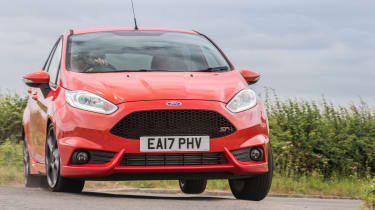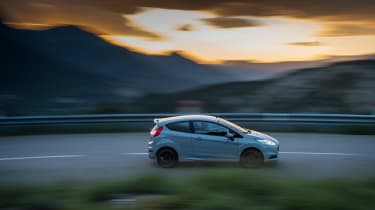Ford Fiesta ST Mk7 review (2013-2017) – ride and handling
The ST was evo’s favourite junior hot hatch, hopefully the new one will be just as fun
This is where the Fiesta ST really shines. Its chassis is so well resolved and so engaging that the ST really is one of the most enjoyable cars on sale at any price. The car turns into corners with real immediacy and very little roll, so it seems to dart towards the apex. The rear end of the car also feels quite lively after the turn in point to a corner – not enough that the driver has to correct a slide, but enough to make the car feel supremely agile.
There is a tautness to the way the car rides over bumps, but the damping is so expertly judged that it never feels uncomfortable. When the road rises and falls that tautness becomes rock solid body control, which – when combined with the low kerb weight – means the ST always keeps iron fisted control of its masses. On the right road, the ST is as enjoyable and addictive as many performance cars that cost five times the price.
The steering is ideally weighted, accurate and feelsome. The brakes stand up to abuse well, too, and the pedal feel is good.
The Fiesta ST isn’t just fun to drive on the open road, it’s also quiet and comfortable on the motorway and civilized around town - much like a normal Fiesta in that respect. That the ST is priced so closely to more humble examples of Ford's small car, yet shares all their benefits, only makes it seem even better value.
More reviews
The ST200’s chassis has been tweaked with slightly softer springs and dampers all round and a stiffer rear torsion beam and front anti-roll bar – both by 33 per cent – in an effort to improve both ride quality and handling precision. Those upgrades were quietly rolled out on all Fiesta STs at the end of last summer, however, so they’re not unique to the ST200.
You’d need to be very familiar with earlier versions of the ST to notice those chassis teaks. In isolation the two cars behave in much the same way, but the increased roll stiffness and slightly more neutral chassis balance are evident. On bumpy roads the car does feel very tautly sprung at low speeds, despite the softer spring rates, but that does settle once on the move. The ST200 is every bit as entertaining as the standard car, but ultimately it doesn’t do anything the ST cant’ do.
Initially, the five-door ST exhibits the same eager, lively character as the three-door version; it turns in sharply with the rear axle aiding it around a corner. There’s barely a hint that there are any downsides to the extra two doors. But, where three-door version can be provoked beyond the limits of the tyres and still feel alive and controllable – enough for you to effectively use that extra rotation to push the car even harder. The five-door isn’t quite as up for it, though. As the grip diminishes the Fiesta’s pace seems to reduce in turn, it feels scruffy and difficult to maintain the same flow that the three-door car clings onto no matter what. Such scenarios, where you’re able to drive like this, are rare so, for the most part, there really is no downside to the more practical ST. But for those occasions are important to relish, so make the kids, your friends, your family and your colleagues clamber over the front seats to get into the back, it’ll be worth it when you’re on the right road.
evo Comment
‘The outstanding thing about the Ford Fiesta ST is that it’s as much fun to drive on a great stretch of road as many cars that are several times more expensive. It’s also comfortable and civilized in every day use, which makes it a very easy car to recommend.
'One thing that gave the engine more oomph was the Mountune upgrade (£659), which lifted power from 179 to 212bhp and was fitted at around the same time as the ST’s only service (£169). The results were subtle, but effective – I think it’s something to have done after you’ve run the car in standard trim for a while, just so you appreciate the improvement.' - Henry Catchpole




